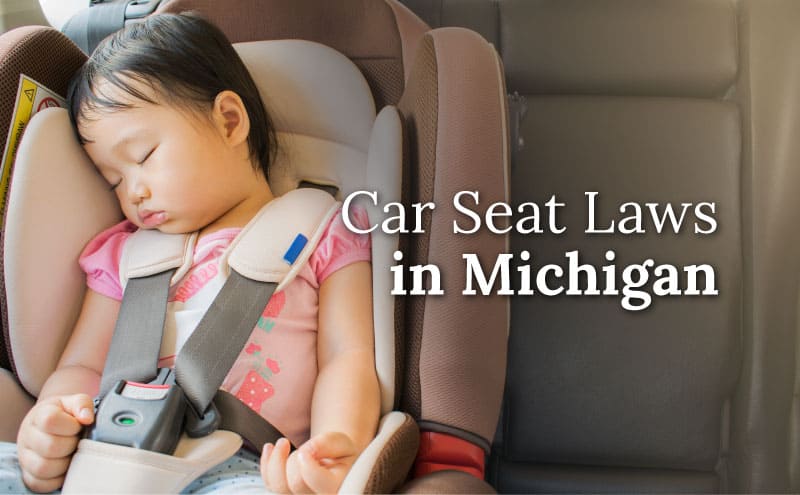Michigan Car Seat Laws – What You Need to Know

Car crashes are the leading cause of death in children ages one to thirteen – a statistic that may certainly scare parents and anyone else transporting children in their vehicles. However, recent data also shows that a large percentage of child passengers killed in car accidents were not properly restrained. These statistics serve as an important reminder that the best way to keep child passengers safe is to make sure they are properly secured in your vehicle. As a personal injury law firm, we, unfortunately, see a range of injured people come through our doors, including children. Because of this, we’ve made it our mission to help educate the public on safety matters, and even host events aimed at keeping Michigan kids safe. As part of that mission, we hope you find the following article as a helpful guide to the current Michigan car seat laws and safety requirements for child passengers.
Michigan Car Seat Laws and Requirements
Michigan car seat laws help protect children in the event of an accident. These laws are based on a child’s age and/or height. Parents should be aware that the requirements for their child’s car seat will change as their child ages.
-
Children under four years old
Under Michigan law, children under four years old must be properly secured in a “child restraint system,” otherwise known as a car seat. From birth until the age of two, children must ride in a car seat in the back seat and must be facing the rear of the vehicle. However, if there is no back seat or it is being used by other children who are also under four, a child may ride in the front seat so long as they are still facing the rear of the vehicle and the airbag has been turned off. From the ages of 2-4, children may travel in the back seat in a forward-facing car seat.
-
Children older than four but younger than eight
Under Michigan car seat laws, Children that are older than four but younger than eight must be properly secured in a “child restraint system in accordance with instructions from the manufacturers of the child restraint system and the vehicle as well as with federal safety requirements.” This age group commonly sits in a booster seat. Importantly, while this requirement is for a specific age, the child must also be less than four feet and nine inches in height. This is because a booster seat allows a child to sit at a height that allows their seatbelt to function most effectively. Once a child reaches eight-years-old or the height requirement, he/she can ride without a booster seat. However, the child must remain seated in the back and must be buckled up at all times.
-
Children older than eight but younger than 16
From the ages of eight to sixteen, children will grow and change quite a bit. Most organizations recommend that from eight to 13, a child should remain seated in the backseat and buckled up and all times. Once a child hits age 13, he or she may be able to ride in the front seat.
-
Children sixteen and up
Children older than 16 must “wear a properly adjusted and fastened safety belt” while sitting in the front seat. While the law does not address whether a child older than 16 can sit in the back seat without a seat belt, it is always the more responsible choice to advise the child to wear a seatbelt.
No-Fault Benefits and Michigan Car Seat Laws
While properly followed Michigan car seat laws can help keep your child safe in the event of a car accident, improperly installed car seats (or the absence of any car seat at all) can often result in serious injury to children. If a serious injury to your child occurs, parents need to realize their child should be able to bring a claim for no-fault PIP benefits. This is true even if the parent does not qualify for no-fault benefits – either by failing to properly insure a vehicle or by failing to bring a no-fault benefit claim on time. Although these failures may disqualify parents, their children may still receive no-fault benefits. For example, the time limitations for filing a claim for no-fault benefits often do not apply to a child until they reach the age of 18. You can read more about notification requirements and time limitations for minors involved in car accidents on page 32 of our brochure “Protecting the Injured: a Summary Guide to the New Auto No-Fault Law.“
In the same respect, events like a parent’s failure to insure a vehicle do not disqualify a child from bringing a claim for no-fault benefits.
Issues involving children’s rights to no-fault benefits can often be complicated. In order to protect the rights of your child, it can be critical to obtain a skilled Michigan auto accident attorney who understands the complex rules surrounding no-fault benefits for minors. Our attorneys at Sinas Dramis Law Firm have helped many Michigan families advocate for the rights of their injured children in the unfortunate event that car seats do not go far enough.

